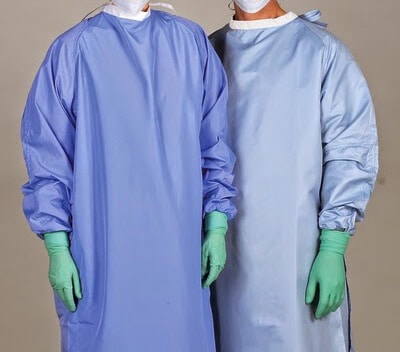In the race for more protective clothing for medical professionals during the COVID-19 pandemic, innovation has occurred in antiviral fabrics.
According to Innovation in Textiles:
“The COVID-19 pandemic has spurred innovation in fabrics with antiviral properties for medical protective clothing, according to a recent report in Performance Apparel Markets from the global business information company Textiles Intelligence.
“Medical protective clothing has long played a vital role in ensuring the safety of health care workers, the patients they treat and the general public. However, the COVID-19 pandemic has brought the importance of medical protective clothing to the fore.
“This is because medical protective clothing and other items of personal protective equipment (PPE) play a crucial role in preventing the spread of the disease. COVID-19 can be caught by breathing in droplets of body fluids expelled from an infected person as he or she coughs, sneezes or speaks. It may also possible to catch COVID-19 by touching a surface which has been contaminated by droplets of body fluids landing on it, and then touching the eyes, nose or mouth.
“COVID-19 is caused by a novel coronavirus, and so the rapid development of antiviral finishes and fabrics with antiviral properties has been seen as a priority by a number of the performance textile industry’s key players, including Ascend Performance Materials (Ascend), Carrington Textiles, HeiQ, Milliken & Company (Milliken), Polygiene, and Rudolf Group.
“Such developments are now being used in the manufacture of a number of protective products such as face masks and reusable gowns, and it is hoped that these products will help to prevent the spread of the disease while also protecting health care workers as they treat COVID-19 patients.
“However, the outbreak of COVID-19 has also presented significant challenges to suppliers of medical protective clothing and PPE. Early in the pandemic, global demand for medical protective clothing and PPE was outstripping supply and shortages of single-use products such as face masks – which are made from various materials, including nonwoven fabrics – were particularly acute.
“As Western countries attempted to stockpile PPE, their dependence on China for supplies was highlighted as a major concern. In an attempt to overcome this issue, a number of nonwovens manufacturers have focused on ‘nearshoring’ and invested in new production facilities in order to serve domestic markets.
“Also, manufacturers of consumer products such as fashion apparel have responded to the call for medical protective clothing and PPE, and several have adapted their supply chains at an impressive speed in order to further boost supplies. Companies which have risen to the challenge include Burberry, Cone Denim, Fanatics, HanesBrands, Kontoor Brands, Nike and Prada.
“Looking to the future, attention is being turned to the development of products which are made from environmentally sustainable materials. This has been highlighted as an area of concern because most single-use products, such as face masks, are made from materials incorporating synthetic fibres derived from petroleum products rather than fibres derived from renewable sources. Furthermore, most synthetic fibres are not biodegradable.
“Meanwhile, demand for medical protective clothing and PPE will remain high for the duration of the pandemic. As yet, no effective treatment or vaccine for COVID-19 had been found and therefore medical protective clothing and PPE will continue to play a critical role in controlling the spread of the disease.”










